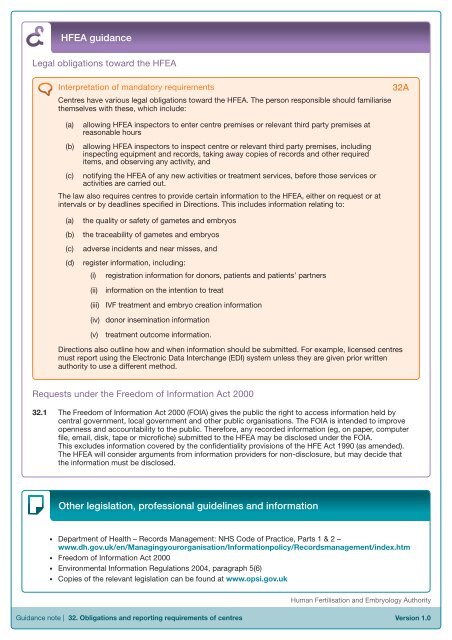Eighth Edition - R.3 - Human Fertilisation & Embryology Authority
Eighth Edition - R.3 - Human Fertilisation & Embryology Authority
Eighth Edition - R.3 - Human Fertilisation & Embryology Authority
Create successful ePaper yourself
Turn your PDF publications into a flip-book with our unique Google optimized e-Paper software.
HFEA guidance<br />
Legal obligations toward the HFEA<br />
Interpretation of mandatory requirements<br />
Centres have various legal obligations toward the HFEA. The person responsible should familiarise<br />
themselves with these, which include:<br />
(a) allowing HFEA inspectors to enter centre premises or relevant third party premises at<br />
reasonable hours<br />
(b) allowing HFEA inspectors to inspect centre or relevant third party premises, including<br />
inspecting equipment and records, taking away copies of records and other required<br />
items, and observing any activity, and<br />
(c) notifying the HFEA of any new activities or treatment services, before those services or<br />
activities are carried out.<br />
The law also requires centres to provide certain information to the HFEA, either on request or at<br />
intervals or by deadlines specified in Directions. This includes information relating to:<br />
32A<br />
(a)<br />
(b)<br />
(c)<br />
(d)<br />
the quality or safety of gametes and embryos<br />
the traceability of gametes and embryos<br />
adverse incidents and near misses, and<br />
register information, including:<br />
(i) registration information for donors, patients and patients’ partners<br />
(ii)<br />
information on the intention to treat<br />
(iii) IVF treatment and embryo creation information<br />
(iv) donor insemination information<br />
(v) treatment outcome information.<br />
Directions also outline how and when information should be submitted. For example, licensed centres<br />
must report using the Electronic Data Interchange (EDI) system unless they are given prior written<br />
authority to use a different method.<br />
Requests under the Freedom of Information Act 2000<br />
32.1 The Freedom of Information Act 2000 (FOIA) gives the public the right to access information held by<br />
central government, local government and other public organisations. The FOIA is intended to improve<br />
openness and accountability to the public. Therefore, any recorded information (eg, on paper, computer<br />
file, email, disk, tape or microfiche) submitted to the HFEA may be disclosed under the FOIA.<br />
This excludes information covered by the confidentiality provisions of the HFE Act 1990 (as amended).<br />
The HFEA will consider arguments from information providers for non-disclosure, but may decide that<br />
the information must be disclosed.<br />
Other legislation, professional guidelines and information<br />
<br />
<br />
<br />
<br />
Department of Health – Records Management: NHS Code of Practice, Parts 1 & 2 –<br />
www.dh.gov.uk/en/Managingyourorganisation/Informationpolicy/Recordsmanagement/index.htm<br />
Freedom of Information Act 2000<br />
Environmental Information Regulations 2004, paragraph 5(6)<br />
Copies of the relevant legislation can be found at www.opsi.gov.uk<br />
<strong>Human</strong> <strong>Fertilisation</strong> and <strong>Embryology</strong> <strong>Authority</strong><br />
Guidance note | 32. Obligations and reporting requirements of centres<br />
Version 1.0

















